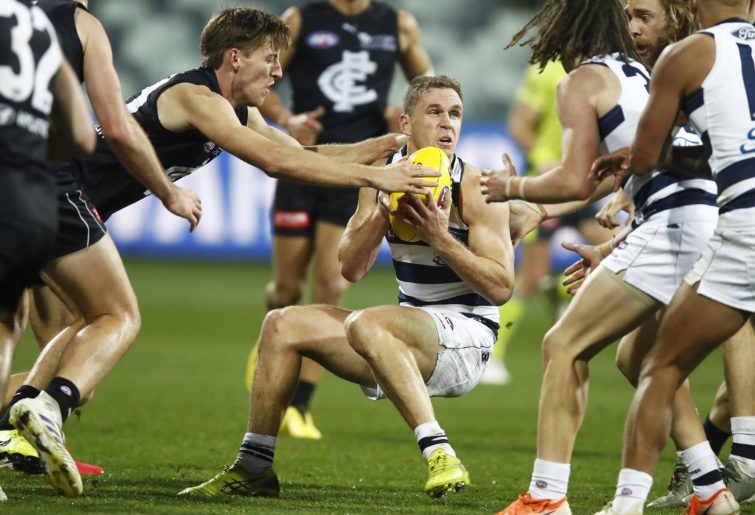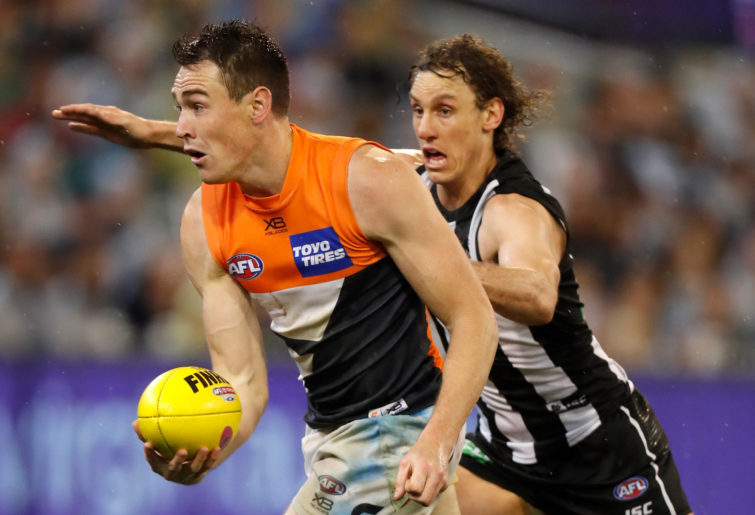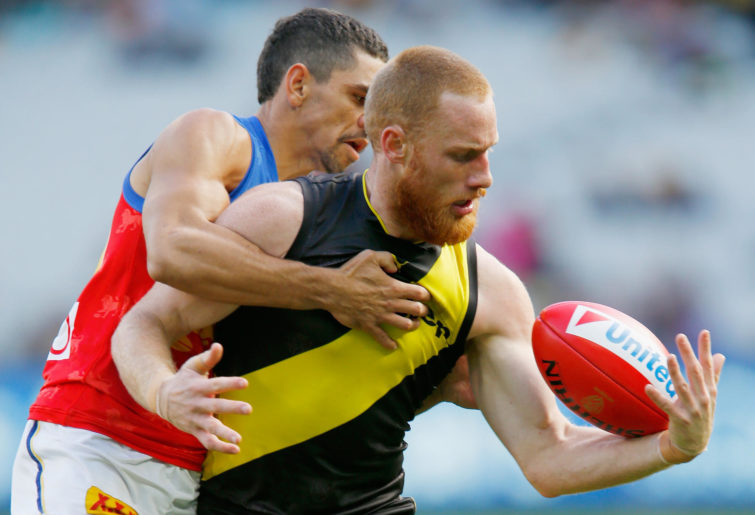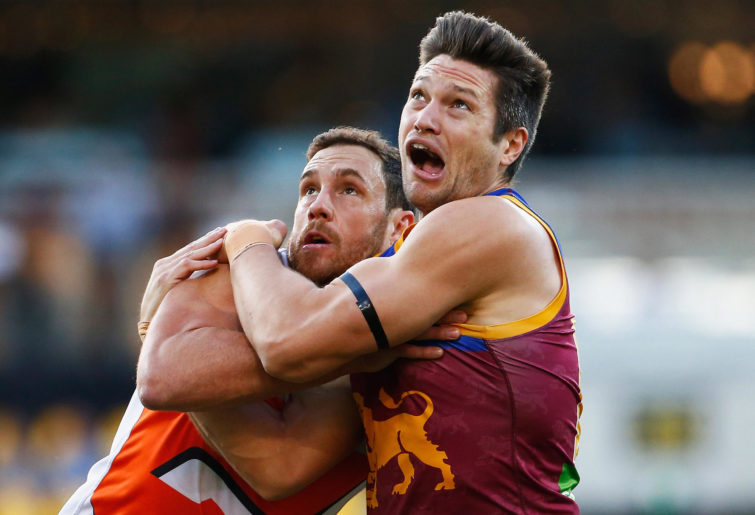Here we go again: the annual bemoaning of the game as a spectacle.
As usual, everybody’s got ideas on how to fix it, but before we do any of it, can we please consider how changes might schism into new negative aesthetics?
I believe a lot of the issues today have evolved from the AFL’s intent to keep the ball and thus the game in motion.
Keeping the ball in motion
‘Deliberate’ used to be this odd little rule enforced irregularly. Now it’s paid regularly. I think that’s great. You know when a player has deliberately hit the boundary line. I just wish umpires would apply some common sense.
For example, a player instinctively clears it out of the pack or streams out of congestion and boots the ball clear. The ball bounces, takes an unexpected spin and goes out of bounds. Now, this is deliberate. Somehow the player planned the unexpected bounce.
Or a player gathers the ball on the boundary line. An opponent charges him. Instead of taking the hit, which will carry him over the boundary line, the ball carrier steps out. It’s the logical thing to do.
Apply some common sense. It’s obvious when a player has played the boundary line. It’s obvious when a player has no options and stepping over is simply producing the result that’s about to happen anyway.

(Photo by Daniel Pockett/Getty Images)
Penalise the last person to touch it before it goes out of bounds
Here are some examples of the AFL’s intent to keep the ball in motion:
- Players no longer have to wait for the goal umpire to wave his flags before kicking out from a behind.
- The player kicking out no longer has to kick the ball to themselves before playing on.
- The umpires have become much harder on deliberate, encouraging players to keep the ball in.
- There is a time limit on how long a player can hold the ball following a mark or free kick before ‘play on’ is called.
- Free kicks, such as for holding the ball and incorrect disposal, are rarely paid, a bugbear I have been going on about for years.
The AFL has deemed stoppages as unsightly because they’re looking at the possible repercussions: congestion. So their mandate has been to keep the ball moving so congestion can’t form.
It’s faulty logic.
Often the ball is kept in motion through imprecise disposal – for example, a player picks up the ball, is tackled and drops it and then somebody else grabs it, is tackled et cetera, or somebody gets a miscued handball or kick out.
By encouraging players to keep the ball in play they have to do so with the weight of numbers around them, which again leads to imprecise disposal.
Then we get rolling mauls, with players trying to win the ball while teammates converge to provide options.
Congestion exists because players have been turned into ruck-rovers who play basketball zones up and down the field. Congestion isn’t a result of stoppages. By demanding the ball be kept in motion it’s drawing the congestion so those zones can maintain their integrity around the ball.
Granted, penalising the last player to touch the ball before it goes out will award a kick that’ll clear congestion. From that standpoint this rule will work.
But here are three issues with the rule:
- We’ll now often be penalising the player trying to win the ball and create the play.
- Fans often complain about players being disincentivised about taking the ball. This is the one rule where we know it’ll happen given we already see players let a ball trickle out so it can be called deliberate rather than take it. It’s already a sickening enough spectacle seeing players turn en masse to appeal for a deliberate even before the ball’s gone out the way a slips cordon would appeal for a catch following a possible edge.
- Are we going to have situations where we need to go to review to work out who touched the ball last? It’ll happen, slowing the game down more.
Some thought needs to be given to the possible consequences of this rule. In my opinion, the bad outweighs the good.

(Michael Willson/AFL Photos via Getty Images)
Pay more frees
Football’s always had good rules. It’s just that they’re either diluted or qualified with stupid interpretations.
An example: we’ve always had push in the back, but then we had to qualify it with hands in the back.
A push is a push. It shouldn’t need qualification. A push impinges a player from competing for the ball. Hands in the back might’ve been well intentioned, but it resulted in a player penalised for having a hand on an opponent’s back despite not applying pressure. It was also a free kick that was inconsistently applied and then devolved into a novelty.
Now it’s gone – an admission that it was a shocker.
Incorrect disposal is something that should be paid 100 per cent of the time. Tacklers need to be rewarded, which is something I have bemoaned for years. Tackling is a cornerstone of our game, and yet too often and for too long it’s been ignored and gone largely unrewarded.
A free kick will immediately clear congestion. If players learn that free kicks will be paid consistently, it could mitigate congestion. If players learn frees will be paid, teammates might hold back to provide options knowing the ball could be cleared sooner.
Alastair Clarkson had a fair whinge about it the other week and now he’s being criticised. Clarkson is right. The biggest blight on the game is we’ve come to accept players dropping it and throwing it and not disposing of it legally.
Why? When did this become acceptable?
The other issue is another stupid qualification that Nathan Buckley has rightly criticised: prior opportunity. Whether a player has had prior or not, they should be pinged if they dispose of the ball illegally. An illegal disposal is indefensible.
Critics complain that if prior opportunity is eliminated, it’ll discourage players from taking the ball. That’s bull.
This fear was also chorused when the AFL introduced a different rule – that a player would be penalised if they dived on the ball and dragged it in. Has it stopped players diving on the ball? No, because the game is about winning the ball.
Players are operating on millisecond instincts. They don’t have time to assess the repercussions of taking the ball in a pressure situation.
Removing prior opportunity won’t stop players from taking the ball. At the very worst they will soccer it clear from congestion, which is just another kind of win.

(Photo by Darrian Traynor/Getty Images)
Calling play on for marks for backwards kicks
Why do we want more grey areas in the game? This rule was trialled in a preseason years ago, and it wasn’t long before the umpires were making blunders, misjudging whether kicks had gone sideways or backwards. I’m not blaming the umpires. The reality is they’re not always going to be in the best position to evaluate a kick’s direction.
A team should be well within their rights to kick sideways and backwards. They should be well within their rights to do it for a whole quarter if they can get away with it.
Football is a simple game that comes down to one unalterable truth: get the ball.
If one team is chipping the ball around, it’s the opposition’s responsibility to win it back. Why must we introduce a rule to help them do that?
Increasing the distance a kick needs to travel for a mark to be paid
Opposition players will zone around the ball carrier to protect space. Right now they will zone ten to 50 metres around the ball carrier. In these zones they will try to negate marking attempts, stop leads and block run.
If we increase the distance a kick needs to go for a mark to be paid to 20 metres, teammates have to fall back further to provide legitimate marking options. The opposition will have to follow. We’re now sticking more players in less space.
Also, umpires are also notoriously bad at judging ten metres. It’s hard to believe they’ll be better at judging longer distances.

(Photo by Scott Barbour/AFL Media/Getty Images)
Fewer players on the field
The one problem with going to 16 or 14 afield is that you’re fundamentally changing the game. The VFL/AFL has always been 18 on the field. Do we want this big of a change?
Will it clear congestion? That remains to be seen. Theoretically fewer players should mean fewe3r congestion, but there are no guarantees.
Something I’ve gone on about is that players have evolved, and although their endurance, strength and kicking prowess have increased, the size of the grounds remains the same.
Here’s an analogy: as a kid you would’ve played kick-to-kick in your backyard. At some point you would’ve grown up and the backyard became too small, so you then went to a park to play kick-to-kick.
You outgrew your field of play and had to find something bigger.
John Nicholls, AFL hall of famer and ruckman in Carlton’s team of the century, was 189 centimetres tall. Carlton’s current captain and champion midfielder, Patrick Cripps, is 195 centimetres tall. We get bigger and stronger. That’s human evolution. Players 20 years ago never ran the distances players do today.
The ground should grow proportionately to how a player’s size and abilities have grown, but that’s not going to happen. So is decreasing the number of players on the ground going to help? Or will players continue to evolve and learn to compensate for the loss of two teammates?
All the evidence would suggest the latter.

(Photo by Jason O’Brien/AFL Media/Getty Images)
Cap interchange further
I heard Kane Cornes championing capping interchanges further, claiming it would tire players, open up congestion and allow an increase in skill.
It is the first time I’ve heard that a tired player will improve in his output.
Then we have to consider how the body copes with the increased workload. This is one problem with claims interchange capping will help the game revert. Why? How do players unlearn and devolve? Does a player who’s currently running 15 kilometres somehow pace himself to run only 12 kilometres? How do they do that? The only way I know is they run until they drop.
Of course, being competitors, they’ll push themselves to exceed that barrier. So either they break or reacclimate.
If players are breaking, doesn’t that become an OH&S issue? After all, we’re introducing a change that we’re openly acknowledging will fatigue players. I don’t know of any other workplace who wouldn’t flag this as a critical concern.
It’s another rule that hasn’t been thoroughly examined. Capping interchange is a kneejerk reaction to the possibility that rotations could escalate to some unrealistic level. It’s not going to happen.
If rotations were just left alone, clubs would find their optimum number because at some point it would become more taxing to run players off and on than it would be to just let them stay on the field for a few minutes.
Conclusion
The game evolves. It always has, and always will.
The AFL constantly poke it and prod it and kick it to try to make it behave the way they want it to, and it never does. That should be a lesson in itself.
Then you hear some people in football and in the media lament free kicks. The biggest problem in the game is the rolling mauls that form around spillages. If players are struggling to get the ball out, more players will congest.
The vehicles to clear congestion already exist: pay the frees that are there. The congestion breaks up instantly. This has already been proven through the AFL’s handling of another blemish: melees.
Umpires used to try break melees up. Things would settle, then a spot fire would erupt into another altercation. On and on it went, sometimes for minutes.
Now the umpires just throw the ball up. Melees stop immediately. Players pursue the ball. Teammates run off to provide options.
Who cares if there are a lot of stoppages? Outside of James Brayshaw, who cares if there are a lot of free kicks? If you paid the free kicks that were there, it would clear congestion immediately.
In the case that a ball is locked up, an umpire should call it immediately rather than wait ten or so seconds – time in which more players congregate – before determining a ball-up is required.
Maybe the AFL should try rigorously enforcing the rules that have existed for over a hundred years before introducing new ones.

































































































